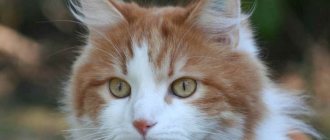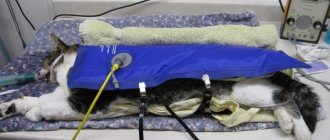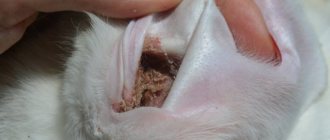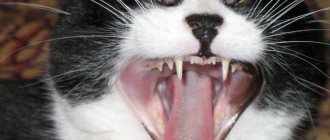What to do if your cat has yellow teeth
Pets also need hygiene, just like people. This is especially true for oral care. Owners often discover that their cat has yellow teeth. Why does this happen and what to do about it?
The first reasons why a kitten's teeth turn yellow may be plaque, tartar or caries. Plaque occurs due to the fact that food remains on the teeth, which are considered half-life products. As a result, a favorable environment for active reproduction appears.
Also, the reasons that cause yellow teeth in cats include the following:
Domestic cats develop plaque on their teeth much more often than indoor cats, who chew grass and gnaw bones, which cleans their jaws. If the pet is under the full care of a person. Then the responsibility for dental health is shifted to the owner.
How to deal with the problem?
If the owner promptly pays attention to the appearance of plaque in the cat and takes all measures to eliminate it, then it will be possible to prevent the development of many oral pathologies.
Tartar is a hard deposit on the surface of fangs and other teeth, so it cannot be removed simply with a brush. Veterinarians use special instruments or the ultrasound method for this.
If the pathology is not advanced, then a gel that is designed to dissolve such deposits on the teeth can help. If tartar has affected the gums, then manipulations are carried out under anesthesia.
You need to understand well that the development of many dental pathologies can be avoided by taking preventive measures and immediately contacting a specialist if changes in tooth enamel occur.
Newborn kittens require special attention.
Injuries as a consequence of communication with.
Along with medicinal methods of struggle.
Change in cat stool - .
Add a comment Cancel reply
- Natalya on How many days does a cat walk?
- Alexander on How to understand that a cat is dying
- Ekaterina on Why cats become aggressive after sterilization
- Elena on Laparoscopic sterilization of cats
- Elena on the post The cat is drooling from its mouth
Or save the link for yourself so as not to lose
Do I need to prepare for treatment and what to do after it?
Detection of calcareous deposits on teeth is carried out during a routine examination by a veterinarian using a special mirror. The doctor must check for inflammation, damage, and tumors in the oral cavity.
After the examination, therapy is prescribed, during which the cat’s tartar is removed. It is best to give preference to specialists in this matter. Home remedies do not always help cope with pathology. With their help it is better to prevent the disease.
You can remove tartar from your cat’s teeth using the following methods:
- Mechanical. This method involves the use of dental instruments to remove the stone. This procedure can damage the teeth if the doctor is not careful or the cat starts to struggle.
- Ultrasonic. This method is considered safer. It consists in cleaning the tartar from a cat’s teeth using an ultrasonic machine.
Currently, veterinarians prefer to remove the stone in three stages:
- Chipping of a formation from a tooth.
- Cleaning the jaw with ultrasound.
- Final teeth grinding.
There should be no stone residue left behind. Otherwise it will arise again. All of these methods cause pain to the cat, so removal is performed using anesthesia. Treatment takes approximately 30-40 minutes.
Before removing tartar from your cat, you need to take some preparatory measures. If the cat is young and has no health problems, then to prepare it is enough not to feed the pet for 12 hours before the operation.
If the cat, in addition to tartar, also has an inflammatory process in the mucous membrane or the gums were injured during surgery, the doctor may advise the use of dental ointments and even prescribe antibacterial agents.
For 7 days after therapy, the cat should be given warm and soft food. If there is pain after surgery. Then you can give painkillers.
What to do if your cat has yellow teeth
Pets also need hygiene, just like people. This is especially true for oral care. Owners often discover that their cat has yellow teeth. Why does this happen and what to do about it?
The first reasons why a kitten's teeth turn yellow may be plaque, tartar or caries. Plaque occurs due to the fact that food remains on the teeth, which are considered half-life products. As a result, a favorable environment for active reproduction appears.
Also, the reasons that cause yellow teeth in cats include the following:
Domestic cats develop plaque on their teeth much more often than indoor cats, who chew grass and gnaw bones, which cleans their jaws. If the pet is under the full care of a person. Then the responsibility for dental health is shifted to the owner.
How to deal with the problem?
If the owner promptly pays attention to the appearance of plaque in the cat and takes all measures to eliminate it, then it will be possible to prevent the development of many oral pathologies.
Tartar is a hard deposit on the surface of fangs and other teeth, so it cannot be removed simply with a brush. Veterinarians use special instruments or the ultrasound method for this.
If the pathology is not advanced, then a gel that is designed to dissolve such deposits on the teeth can help. If tartar has affected the gums, then manipulations are carried out under anesthesia.
You need to understand well that the development of many dental pathologies can be avoided by taking preventive measures and immediately contacting a specialist if changes in tooth enamel occur.
Newborn kittens require special attention.
Injuries as a consequence of communication with.
Along with medicinal methods of struggle.
Change in cat stool - .
Add a comment Cancel reply
- Natalya on How many days does a cat walk?
- Alexander on How to understand that a cat is dying
- Ekaterina on Why cats become aggressive after sterilization
- Elena on Laparoscopic sterilization of cats
- Elena on the post The cat is drooling from its mouth
Or save the link for yourself so as not to lose
Prevention
Preventing the appearance of tartar in your pet is very important and simple. The owner should be aware of the following rules:
- You should visit a veterinarian at least once every six months to sanitize your mouth for prevention.
- Brush your cat's teeth regularly.
- Feed your pet not only soft, but also hard food. In the summer, allow you to eat grass.
- Use special food for cats against tartar.
- Give the animal vitamins.
- Promptly treat any diseases that lead to disruption of the acidic environment in the cat’s oral cavity.
Your pet's teeth should be cleaned using special brushes or regular children's brushes. Cats do not like this procedure. The older they are, the more difficult it is to train them to brush. Therefore, experts advise starting hygiene from an early age.
If tartar has not yet formed, but there is a dense plaque, then hydrogen peroxide can be used to prevent pathology. To do this, moisten the cotton wool and clean your teeth. In this case, do not touch the gums. The procedure should be carried out once a month. After the procedure, you need to rinse your pet’s mouth with water or chamomile infusion.
To prevent your cat from having a similar problem, it is necessary to prevent tartar at home, which includes simple rules:
- Regular brushing of your cat's teeth will help avoid these troubles. Moreover, you need to start teaching your kitten about oral hygiene, because they get used to it more easily than adult cats.
- A balanced diet also prevents problems with stone formation. Dry food has proven itself very well; it contains dietary fiber, which has a beneficial effect on the surface of the teeth and provides additional cleaning.
- Currently, there are commercially available foods that contain polyphosphate, which creates a protective film on the teeth that protects them from plaque.
- Taking vitamins that contribute to the overall health of your pet, and the oral cavity is no exception.
- Gastrointestinal diseases lead to an imbalance in the alkaline balance in the cat’s mouth, so regular medical examinations are necessary to monitor the pet’s health.
- Regular dental examinations by a veterinarian are recommended as a preventive measure for various oral diseases.
At-risk groups
- Tartar in cats usually forms when it reaches an age over five years, especially if the animal’s oral cavity has not been properly cared for. Recently, this problem has also begun to occur in young animals; there is a correlation with the animal’s unbalanced food.
- In veterinary medicine, there is evidence that the most common breeds, such as Persian, Siamese, Scottish, are most predisposed to this disease. This is because sometimes unskilled breeders weaken the gene pool of these sought-after cats.
- Backyard cats living in rural areas and eating natural food are less susceptible to this disease. They have stronger immunity than their elite relatives.
By carefully caring for your cat, you can avoid problems such as the formation of tartar in your pet. If such a problem affects your pet, then the help of a qualified specialist is necessary.
Unfortunately, dental diseases are a common occurrence. In their natural environment, cats clean their teeth mechanically by eating raw meat and chewing cartilage. In addition, a domestic cat lives twice as long as a stray animal - the enamel wears off with age, stress on the teeth leads to mechanical damage, bacteria penetrate through the cracks, which in turn leads to caries and other problems. Many owners make the situation worse because they are simply too lazy to brush their pet’s teeth. To keep your teeth healthy for many years, you need to:
- regularly inspect the oral cavity, removing stuck pieces of food;
- consult a doctor if you notice even minor signs of gum or dental disease;
- feed the cat a balanced diet (if dry food is used, periodically add lines designed to prevent diseases of teeth and gums to the oral food menu).
Since not every owner is able to brush a pet’s teeth (some pets categorically refuse to tolerate a foreign object in their mouth), it is necessary to take the cat to the veterinarian at least once every six months to remove plaque and tartar.
If possible, you should brush your teeth once a week. To remove plaque, use a brush with soft bristles or a special finger attachment equipped with rubber teeth. Human toothpaste is not the best choice; it is wiser to purchase a special toothpaste or gel for pets. The cat is taught to brush its teeth gradually, first by just examining the oral cavity, then touching the teeth with your fingers, then letting the cat chew on a brush with paste applied to it (a paste with a meat aroma and taste that will not frighten the pet with a “chemical” smell is ideal). After cleaning, excess paste should be removed with a sterile gauze swab.
In their natural environment, animals clean their teeth mechanically by chewing cartilage and eating raw meat. Domestic cats mostly eat soft food. Their yellow teeth are a sign of insufficient care. Owners of young and old cats should pay special attention to this.
It is recommended to clean the oral cavity of animals regularly at any age. Modern manufacturers offer pastes with various flavors. For example, you can purchase “Beafar” for an animal. This toothpaste is suitable for a pet of any age. It effectively cleanses the oral cavity, prevents the formation of plaque and tartar, and eliminates unpleasant odor from the oral cavity. In addition, the product has a liver taste.
Animals should be taught to brush their teeth at an early age. To perform this procedure, owners are recommended to:
- let the cat smell the toothpaste;
- take a gauze napkin and wrap it around your finger;
- Start cleaning with the fangs and then move on.
Instead of a gauze napkin, you can take a brush that you put on your finger. It's convenient to use.
To prevent tooth loss and the development of oral diseases, it is recommended:
- regularly inspect your pet's mouth;
- give the animal balanced food, add to the menu food intended for the prevention of gum and dental diseases;
- If your cat has toothache, you should immediately contact a veterinarian;
- When treatment is prescribed, all doctor’s recommendations must be followed.
All dental problems in cats can be eliminated. The health of animals is in the hands of the owners. Don't be lazy about caring for your pets. Cleaning the oral cavity should be done regularly. This short procedure allows you to avoid many oral diseases. You should also not rely entirely on special foods. Thanks to them, the teeth are only partially cleaned.
One of the main concerns of any cat owner is caring for his pet’s teeth. This is extremely important, because cats can also have serious dental problems, and if you don’t give your cat proper attention, the consequences can be dire.
The cat has toothache: dental problems and diseases in cats. How to treat a cat's teeth
Do cats have teeth pain?
Dental problems in cats: symptoms
If a cat has toothache, he will certainly let you know about it.
Dental diseases in cats are manifested by the following symptoms:
- the cat rubs its cheek with its paw or rubs against objects;
- gums become inflamed and swollen;
- Bad breath may appear;
- partial or complete loss of appetite;
- possible darkening of teeth;
- the cat is acting restless;
- increased salivation.
Dental diseases in cats
What types of dental diseases do cats have: caries, osteomyelitis, pulpitis, periodontal disease, as well as stones on the teeth of cats. Only a veterinarian can make a correct diagnosis.
The cat has plaque on his teeth
Plaque on a cat’s teeth appears when the pet is 1.5 years old. As a rule, when a cat has a cat, this does not cause any inconvenience to the animal, but if the cat still shows anxiety, you just need to brush his teeth, it is enough to do this once a week.
The cat has yellow teeth
Stones on cats' teeth
The cat's teeth are rotting
Cat has black teeth
Black teeth in a cat most often indicate the presence of caries or pulpitis, which can be treated by simply installing a filling. If, in addition to a black tooth, the cat has additional symptoms, a veterinary dentist will make an accurate diagnosis.
Tooth inflammation in cats
To avoid complications and further inflammation, you need to brush your teeth and remove tartar.
How to treat a cat's teeth?
A cat's teeth must be treated under general anesthesia.
Please rate the article!
(1 star #8212; didn't like it, 5 stars #8212; liked it)
What to do if your cat has yellow teeth.
Pets also need hygiene, just like people. This is especially true for oral care. Owners often discover that their cat has yellow teeth. Why does this happen and what to do about it?
The first reasons why a kitten's teeth turn yellow may be plaque, tartar or caries. Plaque occurs due to the fact that food remains on the teeth, which are considered half-life products. As a result, a favorable environment for active reproduction appears.
The plaque gradually acquires a yellow color, then darkens even more until it turns brown. It also hardens over the years and eventually turns into tartar and causes tooth decay in the cat. These diseases bring unpleasant symptoms to your pet; gums and teeth can be very painful.
Also, the reasons that cause yellow teeth in cats include the following:
- Age . The older the cat, the greater the likelihood of darkening and yellowing of tooth enamel.
- Pathologies of the oral cavity. If an animal has inflammatory processes in the mouth, then the risk of developing tartar increases significantly.
- Nutrition . A cat's yellow teeth can be due to feeding food with dyes, as well as only soft food that is not able to clean the teeth.
- Lack of hygiene. Cleaning your cat's teeth should be done regularly. You can do this either at home or with the help of a veterinarian.
Domestic cats develop plaque on their teeth much more often than indoor cats, who chew grass and gnaw bones, which cleans their jaws. If the pet is under the full care of a person. Then the responsibility for dental health is shifted to the owner.
24-hour veterinary clinics Svoi Doctor
Student work: Bisingalieva D.Kh. 5th year FVM
Tartar (Calculus dentalis) is calcareous deposits on teeth, usually a mixture of phosphate and calcium carbonate with a minor content of organic matter and various microorganisms. Dark brown or yellowish in color. This color is given to tartar by food debris, bacteria, phosphorus salts, iron salts and other microelements.
Causes
Symptoms
- unpleasant odor;
- salivation;
- difficulty eating;
- jaw clattering;
- temperature;
- purulent nasal discharge;
- vomit.
In dogs, these problems are most often found in most small decorative breeds, such as poodles, Yorkshire terriers, cocker spaniels, dachshunds, toy terriers, lapdogs, etc.
In cats, this disease is more common in Persians, British, and Scottish Folds.
First, a soft plaque forms, consisting of microflora, polysaccharides, and remains of soft food.
Initially, tartar is deposited in those areas of the teeth where sufficient self-cleaning does not occur when chewing food, in places where microbes accumulate, therefore, in veterinary practice, tartar is especially common on the outer surface of the canines, posterior premolars and on the first molars of the upper jaw, causing only retraction and inflammation of the gums, but also ulcerative inflammation of the cheek from the side of the tooth.
The substrates of tartar are food, microbial and tissue detritus of the oral cavity, saliva, and food residues. Plaque is fixed on teeth using the adhesion mechanism, physicochemical processes, and during colonization of the oral cavity by bacteria.
Tartar is protected by a film consisting of glycoproteins, which are not affected by enzymes of saliva and the oral cavity, which allows maintaining its autonomy and contents. The formation of acidic products in soft plaque has a pathogenic effect on teeth and periodontium.
The allergenic, stimulating inflammatory reaction effect of soft plaque on periodontal tissue is also great. Soft plaque can be removed by brushing your teeth. If the soft plaque is not eliminated, then tartar will form over time.
Exists :
1) Supragingival calculus is formed by mineralization of soft plaque; Supragingival is formed on the free surface of the tooth, has a yellow or brown color, a rough surface, which promotes the deposition of new layers and increases the size of the stone.
2) Subgingival – under the marginal gum (it is formed from blood plasma proteins or gingival fluid). Subgingival is located on the root of the tooth, dark green in color, much harder than supragingival. Its formation is associated with biochemical abnormalities in the blood serum, while supragingival depends on the composition of saliva.
Treatment
- Mechanical removal of large stones.
- Ultrasonic cleaning.
- Grinding and polishing of teeth with special pastes.
Treatment is aimed at removing plaque and stones, necessarily removing non-viable teeth, antibacterial therapy, therapy aimed at improving the condition of the gums and oral mucosa, if necessary, detoxification therapy and treatment of concomitant diseases.
Therapeutic treatment consists of prescribing antiseptic and astringent agents. With the development of stomatitis, antibiotic therapy, immunostimulation and vitamin therapy are carried out. An appropriate diet must be prescribed (Hill's Prescription Diet Canine t/d and t/d Mini.).
In general, dental plaque removal is painless and is performed without local anesthesia. In some cases, if the dog is aggressive and excitable, anesthesia and/or local anesthesia is given.
As a result of the impact of dental plaque and tartar on the oral mucosa, stomatitis almost always develops. And even after removing tartar in the cervical area, hypertrophy of the interdental papilla and bleeding of the gums are observed. Therapeutic treatment of stomatitis consists of local use of antiseptic and analgesic astringents (vagotil (1:1000), Trauma-gel).
With severe development of stomatitis, a course of treatment was prescribed with Travmatin injections and locally - turunda in the form of applications with Travma-gel.
During the traumatic process, Travmatin has analgesic, hemostatic, and anti-inflammatory effects. As a result of its use, regeneration processes proceed faster.
Complete and detailed removal of tartar can only be achieved using special dental equipment under general anesthesia. It should be noted that mechanical removal of large stones has only a superficial effect and has little effect on pathogenesis. Subgingival areas need to be cleaned!
Ultrasonic cleaning:
- Piezon Master 400 device.
-Ultradent
The device is designed to apply ultrasound to dental plaque in order to remove it. The presence of a variety of tips allows you to remove stone, plaque from the surface of the teeth and stone from the interdental spaces. After plaque or tartar is removed, the crown of the tooth is polished.
Removing tartar using ultrasound is safe for tooth enamel, and the presence of a variety of attachments allows you to achieve an excellent cosmetic effect
Prevention:
1. Refusal to use fine feed
2. Portioned feeding (only 2 times a day)
3. Using special cleansing seeds after meals
4. Use of specialized feeds, for example Hills Canine t/d
5. Active exercise, walks, etc.
6. Timely sanitation of the oral cavity and prevention of the appearance of dental plaques, as well as preventing their recurrence.
Prevention must be addressed from a very early age, because dental problems in older age will lead to diseases and disorders in other systems and organs.
An animal with bad teeth cannot chew food well enough, and it ends up in the stomach in large pieces and insufficiently processed by saliva. If this happens continuously over a long period of time, then digestive disorders can become irreversible.
In turn, due to disruption of the digestive process, the absorption of digested food is disrupted, and metabolic diseases arise.
With tartar deposits, bacterial contamination of the oral cavity increases many times over. With each sip, the animal receives more and more new portions of bacterial agents. Eventually, the body's immune system can't handle it. A huge amount of bacterial toxins and breakdown products are excreted by the kidneys, which can lead to chronic renal failure.
Also, a large amount of toxins and breakdown products are carried by the blood throughout the animal’s body and settle in places where there is already a predisposition or disease. As a result, treatment of diseases of internal organs must begin with sanitation of the oral cavity.
How to deal with the problem?
If the yellowness of your teeth is due to plaque, then dealing with the problem will not be difficult. You just need to carry out hygiene procedures and continue to do them regularly. In addition to direct cleansing, you can buy chewing toys for your pet.
If the owner promptly pays attention to the appearance of plaque in the cat and takes all measures to eliminate it, then it will be possible to prevent the development of many oral pathologies.
If yellow tartar is found in a cat, you should visit a specialist. He will select the most optimal treatment method depending on the number of affected teeth. It also takes into account whether the gum disease has affected it and how the cat tolerates various manipulations.
Tartar is a hard deposit on the surface of fangs and other teeth, so it cannot be removed simply with a brush. Veterinarians use special instruments or the ultrasound method for this.
If the pathology is not advanced, then a gel that is designed to dissolve such deposits on the teeth can help. If tartar has affected the gums, then manipulations are carried out under anesthesia.
You need to understand well that the development of many dental pathologies can be avoided by taking preventive measures and immediately contacting a specialist if changes in tooth enamel occur.
Treatment and care of teeth in cats.
Teeth play an important role in a cat's life. Thanks to them, the animal captures, holds and chews food. In addition, a cat's teeth are its main weapon. They are needed for self-defense and attack on the victim. However, if not properly cared for, they deteriorate and various diseases occur. Treatment of such ailments must be carried out on time.
How does the removal take place?
Tartar removal is a fairly painful procedure that lasts from 30 to 60 minutes. As a rule, cleaning is carried out in three stages; only compliance with all stages will help to efficiently clean the resulting growths on the teeth. If the procedure was performed poorly or without any point, then the stone will form again, and the animal will have to go through this unpleasant procedure again, which includes:
- Mechanical removal of large stones using dental instruments.
- Ultrasonic cleaning is performed to remove small stones.
- Grinding and polishing of teeth is done using special pastes.
If the animal is old or sick and cannot withstand general anesthesia, then the veterinarian develops a step-by-step treatment of the growth, which is carried out without the use of anesthesia, under the influence of painkillers. In this case, the stone is removed gradually, over several visits to the clinic.
Is it possible to remove tartar at home?
Tartar treatment can only be done in a clinic. Removal at home is impossible, since this is a rather complex procedure, which is done mainly under anesthesia in a veterinary clinic.
Under no circumstances should you remove tartar at home, as this can cause severe pain to your cat and damage its health.
How to prepare a cat for surgery
If, after an examination, the veterinarian prescribed surgery using general anesthesia, the owner must prepare the pet for this unpleasant event at home:
- The young animal must prepare by fasting, which lasts from 12 to 24 hours.
- Elderly cats, or those pets that have any health problems, should be prepared before surgery using laboratory tests and a careful examination by a veterinarian.
Caring for your cat after removal
After treatment has been carried out, the cat will need careful care, which includes:
- Painkillers that can be given at home.
- Food should be semi-liquid, gentle and lukewarm.
Cat's dental system
How many teeth a cat has is a question that interests many owners. Pets are born toothless. The first incisors are cut around the 2nd week of life. Then the canines and molars grow. They are cut from the pet until the end of the 1st month of life. In total, the kitten develops 26 teeth, of which 14 are on the upper jaw, and 12 on the lower jaw.
Milk teeth in cats, like in humans, are replaced by permanent teeth. This process begins at the age of 4 months. The change of teeth in cats is completed at 8 months. 4 additional teeth also grow, and there should be 30 in total (16 on the upper jaw and 14 on the lower jaw). The arrangement of a cat's teeth is quite simple. The dental system of an adult pet includes:
- incisors, located in the front and used to capture prey;
- fangs designed for tearing prey;
- premolars involved in chewing food;
- molars, which are also involved in grinding food.
Dental diseases
Cats are susceptible to various oral diseases (this is especially true for older pets). Very rarely, veterinarians encounter caries in animals. Dental diseases such as gingivitis and periodontitis are diagnosed much more often in cats. Illnesses arise due to poor nutrition, insufficient care, hereditary predisposition and certain infections.
Any disease of the oral cavity is easy to notice. The following signs indicate the occurrence of any illness:
- an unpleasant odor appears from the mouth due to rotting teeth;
- gums begin to redden and become inflamed;
- in some cases, salivation increases;
- natural color changes;
- the animal behaves restlessly, sometimes showing aggression;
- appetite worsens (the animal either refuses to eat or eats food with caution).
The occurrence of dental plaque and tartar
Cats' teeth are naturally white. However, due to improper care, a yellowish or grayish coating appears on their surface. Why it forms is a question that interests many pet owners. The teeth in the oral cavity are covered with a film of saliva, which contains various bacteria. Gradually the film thickens. After some time it turns into plaque. He mainly focuses on the back row and fangs.
If plaque is not removed in a timely manner, it will harden. Tartar will form. The likelihood of its formation increases in the following cases:
- the animal has to eat only soft food;
- the animal’s teeth are positioned incorrectly;
- the pet's salt metabolism is impaired.
Tartar is very tricky. When examining a cat's oral cavity, you can only notice that part of it that is located above the gum. It is impossible to see the tartar underneath, but it is because of it that teeth rot and fall out in the future. Problems with gums also appear.
To remove plaque and prevent stone formation, you can purchase a brush. However, not every pet will behave calmly during the procedure and will not run away. Brushing causes fear in cats. Another solution to the problem is to purchase special additives in drinking water for animals that prevent the formation of stones.
Gingivitis in cats
Another common disease in animals is gingivitis. The main cause of the disease is the presence of tartar in the oral cavity. Predisposing factors are metabolic disorders, diseases of internal organs, and infections.
Gingivitis in cats causes gums to become inflamed. Cracks and ulcers appear on them. The gums begin to bleed. There is also bad breath and drooling. Treatment for gingivitis includes regular brushing of your cat's teeth and removal of tartar. In case of disease, special ointments or gels are applied to the gums (for example, Metrogyl Denta, Zubastik, Dentavedin).
In order to prevent this dental disease in cats, it is recommended to brush them regularly using a special toothpaste for animals and a brush. You can also purchase dry food that helps reduce plaque and prevent the formation of tartar.
Reasons for education
A cat may have tartar on its teeth for many reasons. The most common factors include the following:
- Lack of pet oral hygiene.
- Feeding the animal predominantly soft food.
- Failure of the salt exchange process.
- Pathologies of dental structure.
- Violation of the integrity of tooth enamel.
Over time, plaque on the jaw becomes hard and eventually turns into tartar. This disease threatens the cat with the fact that the teeth will gradually begin to decay, up to the complete loss of the entire jaw. The stone is located under the gums, so removing it presents some difficulties.
In veterinary medicine, there are several reasons that influence the formation of tartar:
- Improperly balanced cat nutrition. The lack of natural food leads to the formation of microorganisms, which, when interacting with saliva, lead to the formation of deposits.
- Incorrectly formed bite.
- Metabolic disorders in the cat’s body lead to improper salt metabolism, resulting in the growth of tartar.
- Insufficient oral care.
- The presence of inflammation of the gums.
Development of periodontitis
By this term, veterinarians understand the inflammation of the tissues that surround the root. The disease occurs due to bruises, cracks, and inflammatory processes occurring in the oral cavity. With periodontitis, a cat's gums become swollen. The animal refuses to eat because it feels pain. The tooth, located in the place where the inflammation is localized, begins to loosen.
Veterinarians, diagnosing this disease in a pet, prescribe disinfectant solutions. They are used to rinse the cat's mouth. The treatment will also bring good results if calendula infusion is used. The product relieves inflammation and has a bactericidal effect. If purulent-diffuse periodontitis is diagnosed, then veterinarians recommend removing the tooth.











